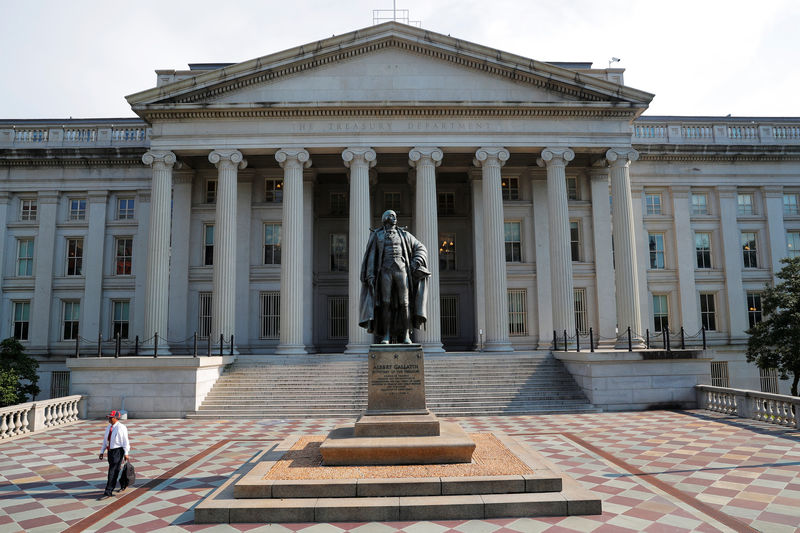By Kate Duguid
NEW YORK (Reuters) - A longstanding bond trade has been put on ice thanks to a changing climate in the U.S. Treasury market, which is being buffeted by a flood of supply and a drought in volatility.
The premium typically commanded by the newest vintage of Treasuries, so-called on-the-run bonds, over their older, or off-the-run, counterparts has been squeezed by these two forces to historically low levels.
This is draining the appeal of playing the difference between them that had been a favorite among hedge funds and other relative-value investors who seek out gaps in the "fair value" of securities.
"You've seen a serious pullback from a lot of Treasury traders, especially relative-value traders in terms of the amount of balance sheet that they're allocating to U.S. Treasury strategy because everything is so close to fair," said David Rice, head of relative-value arbitrage at the Gelber Group.
U.S. government debt issuance topped $1 trillion in a single month for the first time in August as the Treasury raised funds to pay for the Republican tax cut, higher defense spending and to cover a gap created by the Federal Reserve slashing its own bond holdings.
Even accounting for maturing securities, net issuance since the current federal fiscal year began last October totals $1.06 trillion, according to Securities Industry and Financial Markets Association data, the most since 2012, and is only expected to grow.
With little to no premium in that flooded on-the-run market, investors are holding on to their off-the-runs, making it harder to buy and sell U.S. government debt in what is meant to be the most liquid bond market in the world. Treasury market average daily trading volumes are up just 5.1 percent so far this year, SIFMA data shows, even as net issuance is 2-1/2 times last year's level.
The increased size of the newest auctions pulls away some of the liquidity premium that on-the-runs would have commanded had they been smaller.
Gelber Group's Rice said they were "running leaner positions than we have in the past" because of the historically low liquidity premiums.
On top of that, bond market volatility remains obstinately low even as yields grind higher and prices lower in the face of a booming economy and a hawkish Fed, which is expected to raise its benchmark lending rate on Wednesday.
A shaky period in the market earlier this year didn't hold, and a widely tracked measure of volatility from Bank of America/Merrill Lynch is back near record lows, which is also limiting opportunities to trade market dislocations.
Volatility may pick up some after the Fed meeting on Wednesday if, as a growing number of analysts expect, policymakers signal more rate hikes through the end of 2019 than they had previously indicated. But Gelber's Rice doesn't see that lasting for now.
"Chatter around the market is that people are not super hopeful for a pick-up in volatility until midterm elections, which is what they see as a possible turning point if there is a 'blue wave' and the House and Senate go to Democratic control," he said. "I tend to agree."
Meanwhile, off-the-runs continue to trade as close to "fair value" as they ever have.
The spread between the current benchmark 10-year note yield (US10YT=RR) and the 10-year note issued two months prior is 0.26 basis points. In November 2016, after the presidential election jolted the market, the spread was 3.69 basis points.
At the short end of the curve, where there have been the biggest increases in supply, spreads are negative. The spread between the benchmark one-month Treasury bill and the bill issued two months prior is currently minus 10.56 basis points. In November 2016 it was 0.97 basis points.
"Broadly speaking, yes (off-the-runs) are trading close to fair value," said David Ader, who was until recently the chief macro strategist at Informa Financial Intelligence. "If things are fair value, if there are no obvious mispricings or even less-obvious positions there's no reason to put on big positions. What are you playing for?"
